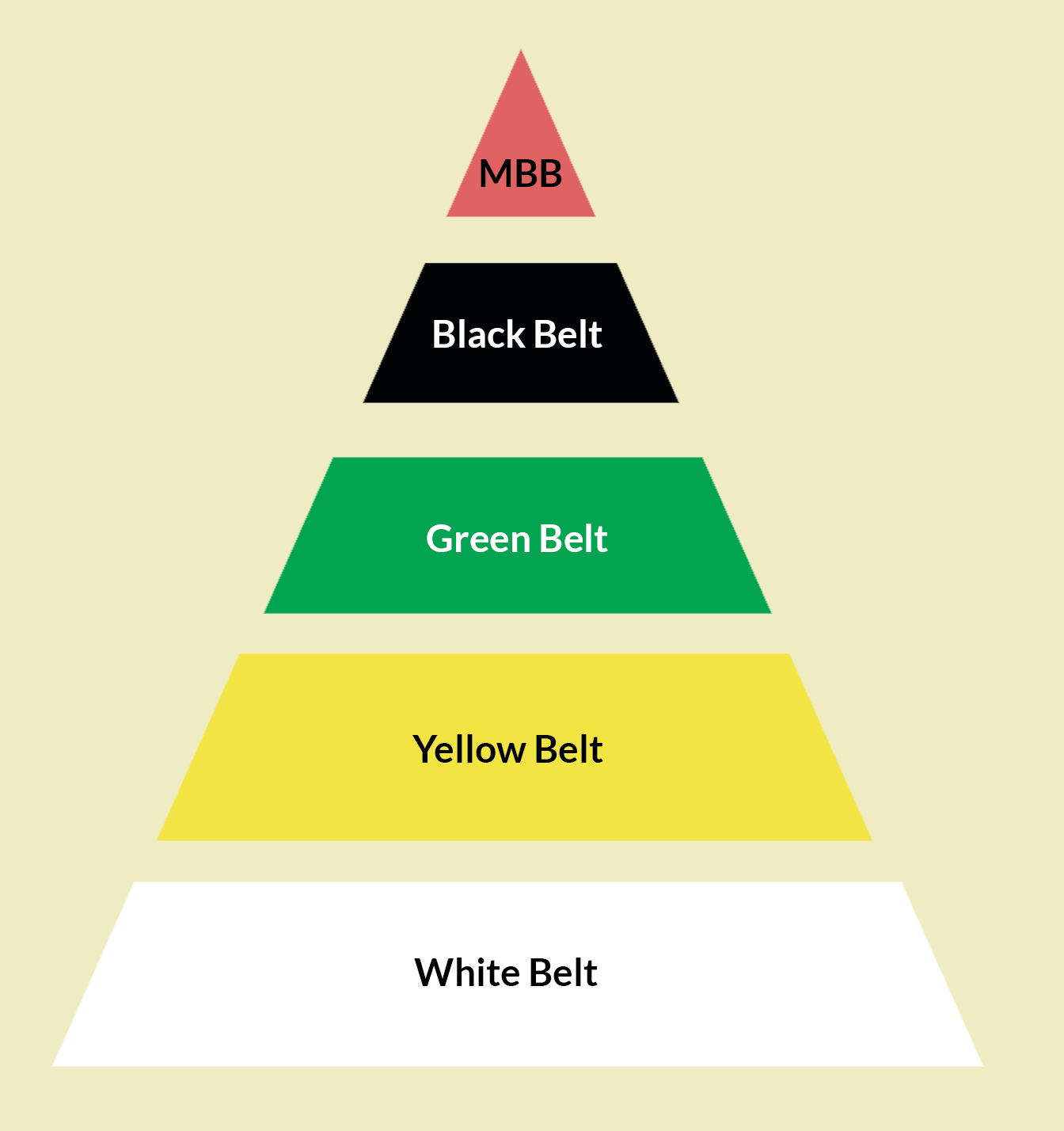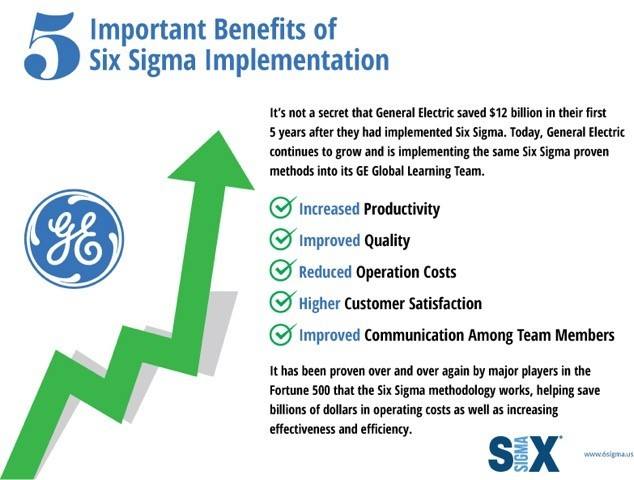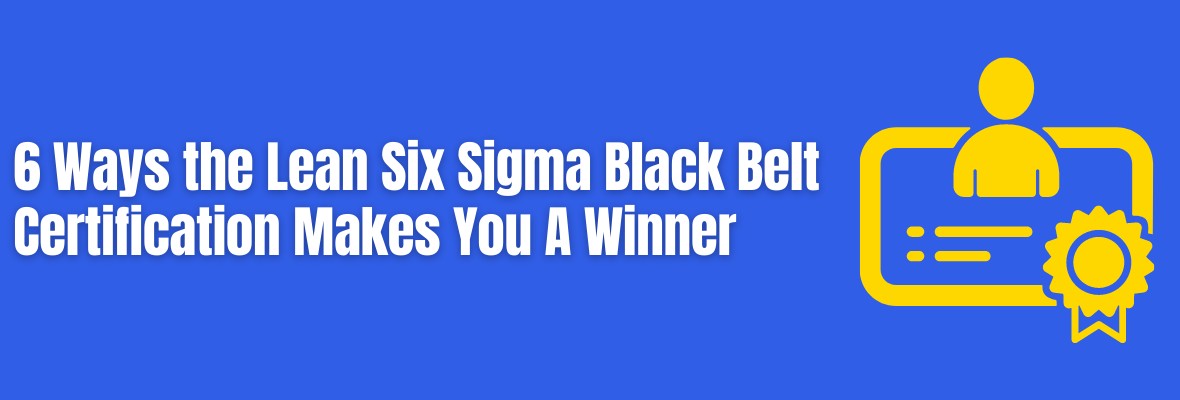6 Ways the Lean Six Sigma Black Belt Certification Makes You A Winner
Six Sigma needs no introduction. It has been a tried and tested technique used for many years by organizations to optimize their processes and improve quality.
Six Sigma is a set of tools and techniques for process improvement. It was introduced by Bill Smith, while he was working at Motorola in 1986. Six Sigma was made central to business strategy at General Electric by Jack Welch in 1995.

Source: Pinterest
How would you embed lean thinking in your actions? Can you do Lean Six Sigma Black Belt training online? In this article, you will learn more about how Lean Six Sigma Black Belt certification gives you the winning edge.
What is Six Sigma?
Six Sigma is a method that provides organizations with tools to improve their business processes and capabilities. There’s an increase in performance and decrease in process variations due to Six Sigma. This helps reduce defects and improve the quality of products or services, profits, and employee morale. Six Sigma aims to improve quality by finding defects, identifying their cause, and improving processes. Process improvement focuses on increasing the repeatability and accuracy of process results.
Statistics uses the bell curve where one sigma symbolizes a single standard deviation from the mean. The defect rate is classified as extremely low if the process has six sigmas - three above and three below the mean. A six-sigma process will occur when there are no defects expected in 99.99966% of all chances to produce them.
Six Sigma Belts

Source: GreyCampus
Yellow Belt: This person supports Green Belts and gains an understanding of basic principles. He/she will review process improvements.
Green Belt: This person may lead small projects and supports Black Belts. He/she will do analysis and collect data for Black Belt Projects.
Black Belt: This person will be working full-time as a Black Belt and leading projects. He/she will also mentor other Yellow Belt and aspiring Green Belts.
Master Black Belt: This person is a subject matter expert and works at a Program level. He/she also develops material and coaches.
What is Black Belt Certification?
Lean Six Sigma Black Belt training and certification is a globally recognized certification. It is valid and applicable across industries. Lean is a combination of tools and techniques that help improve efficiency and quality. It also helps reduce the time to deliver products. Lean Six Sigma Black Belt Certification determines the capability of an individual to use his/her skills in an enterprise, for full-time process excellence roles.
Roles and Responsibilities of a Lean Six Sigma Black Belt
1) A Lean Six Sigma Black Belt certified professional should develop a proper project plan.
2) A Lean Six Sigma Black Belt certified professional should train team members and embed Lean Six Sigma principles and methodologies in his teams.
3) A Lean Six Sigma Black Belt certified professional instructs and mentors Green Belts.
4) A Lean Six Sigma Black Belt certified professional successfully closes Lean Six Sigma Projects and share results.
5) A Lean Six Sigma Black Belt certified professional uses a top-down communication strategy and maintains proper communication in Lean Six Sigma.
The Lean Six Sigma Black Belt Certification generally takes around three months to complete, depending on the provider and project requirements.
The Council for Six Sigma Certification (CSSC) states that a Certified Lean Six Sigma Black Belt is an individual that possesses good knowledge and understanding of the entire Six Sigma body of knowledge. In addition, this individual has a good grasp of both Six Sigma principles and philosophies, including supporting tools and systems. The Black Belt Certification designation also reflects an understanding of team dynamics, team leadership, and the ability to successfully assign responsibilities and roles to team members. Finally, a Certified Lean Six Sigma Black Belt should have a high-level of understanding of the DMAIC (define, measure, analyze, improve, and control) model in accordance with the Six Sigma principles. He/she should have skills to quickly identify “non-value-added” activities and have a basic knowledge of lean enterprise concepts.
Two Different Paths to Certification
The CSSC (Council for Sigma Certification) has two paths to earn a Lean Six Sigma Black Belt Certification. Individuals who have already done training and sense that they have a good understanding of the topics covered in the Six Sigma Black Belt Certification body of knowledge, can simply sit for the standard comprehensive examination.
Individuals who are instead, using free self-study guides, in conjunction with a training provider or independently, can sit for several short exams as they progress through the different sections (as opposed to a single, larger, comprehensive exam).
As an additional benefit, those selecting the second option toward certification, will be able to obtain different levels of Six Sigma certifications (White Belt, Yellow Belt, Green Belt, and Black Belt) as they progress through their certification journey.
The multi-exam path would be a good option for professionals looking for a solid refresher, who are newer to the methodology, or those who would like to reduce their overall examination and certification costs.
6 Ways the Lean Six Sigma Black Belt Certification Gives You the Winning Edge
1. Embed Lean Techniques: Help your organization reduce risks and eliminate defects. This is something all organizations are looking for, and you will be able to drive that for your organization.
2. Improve Business Processes: You will be able to analyze your organization’s business and manufacturing processes and actions to make improvements. Black Belt Six Sigma Certification will enable you to conduct a complete review of existing practices and understand how they impact quality and performance. There are two parts to this: improve the process, and ensure it is sustainable. Both are critical to any long-term goal for operational efficiency. Black Belt Six Sigma Certification shows you how to apply its tools and techniques, and help you contribute to long-term strategies.
3. Increase Value Across Industries: Six Sigma works across and is applicable to most industries. So, you get the edge by using your experience in one industry and making improvements in another industry, which may or may not be related. Six Sigma techniques are applied in electronics, telecommunications, aerospace, banking and financial services, HR, marketing, IT, and other industries. Certified professionals are knowledgeable in dozens of different methods that can be applied to reduce costs, streamline business processes, and improve employee acceptance. This will help increase revenue, leading to a better bottom line, irrespective of the industry.
4. Enhance Career Progression: Black Belt Six Sigma is a globally recognized certification. Many organizations are specifically looking for professionals who are Black Belt certified. You will gain a clear understanding of quantifying and measuring financial benefits from executing any Six Sigma project. This helps professionals acquire financial management skills and conduct risk assessments. Such skills are highly valued by top-level and middle management for senior managerial positions. Black Belt Six Sigma will help you progress in your career, get a higher position, and push your limits. It will act as a catalyst for your career progress and growth!
5. Advance Salary Growth: Black Belt certified professionals earn excellent industry-standard salaries. Your salary will depend on your experience and industry. General figures for Lean Six Sigma salaries, by certification level, are shown below.

Source: Pinterest
Hands-on work with industry projects is included in Six Sigma training. It also provides the implementation of theoretical principles to real-life scenarios. This certification helps you gain appreciated experience even before joining the workforce.
6. Gain Hands-on Experience: While working toward the certification, you come across many use cases and practical examples where Six Sigma has improved quality. You apply it to your projects and gain experience in best practices, which can be leveraged for other projects. The hands-on experience gained is indispensable.
How Six Sigma Benefits Your Organization?

Source: GreyCampus
1. Reduce Costs: Six Sigma ensures defects are reduced and waste is minimized. This results in low production costs and increased profits. Organizations pay high direct and indirect costs with low-quality products. Six Sigma will ensure good quality and service to eliminate this risk.
2. Improve Productivity: Lean operations and efficient processes result in resource productivity improvements.
3. Boost Customer Confidence: Six Sigma prepares you to help customers streamline processes and increase customer satisfaction. You will help your customers identify wasteful steps and processes and correct them. Improved product quality and results will eventually boost customer confidence.
4. Win Stakeholder Trust: Grain credibility by ensuring your employees are Six Sigma certified. With this certification, you indicate that quality is of the utmost importance. Investors and partners will gain confidence with a quality-driven organization.
5. Reduce Employee Turnover: With a high focus on quality and employee empowerment, employees will know that your organization and their projects will succeed. Plus, growth in Six Sigma levels will ensure growth for employees and your organization, which is win-win. Employees will have pride and trust in the organization, resulting in improved job satisfaction and reduced turnover.
How to Approach Six Sigma Projects in an Organization?
First, you must know exactly what you want and what you want to fix. Check for variation in activities and how you can measure it. Workarounds may be a solution, but Lean Six Sigma focuses on removing the root cause in the true sense. Six Sigma must be core to your organization’s quality initiatives to ensure fruitful operations and measurements. Your organization should be process-oriented and incorporate Six Sigma into business processes to increase success probability. There may be some obstacles during executions, which are internal and may be due to different employee values. Gain employee and management buy-in; ensure they know what they are doing and why, the impact, and their contributions!
Six Sigma ensures quality! With a focus on quality and employee empowerment, your employees will know that their projects and organization will succeed. Employee career progression will correspond to growth in Six Sigma levels. This will also ensure growth for the organization. This is a win-win! So, it is time you get started with your Six Sigma Black Belt Certification!
Want to Ace Quality Management? Consider Getting Lean Six Sigma Black Belt Certified Today!
